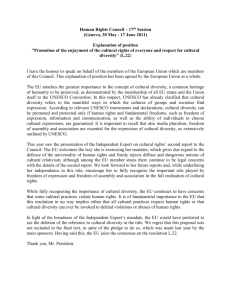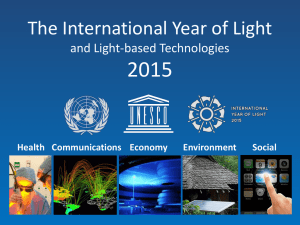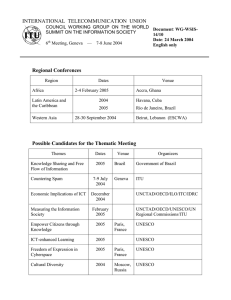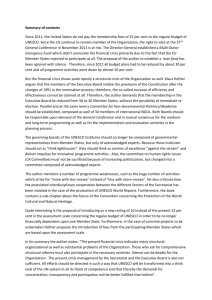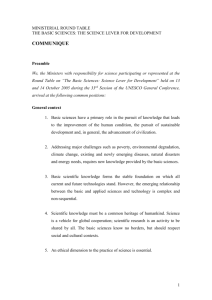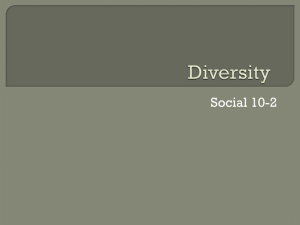The implications of global challenges for education for shared values... and interfaith understanding
advertisement
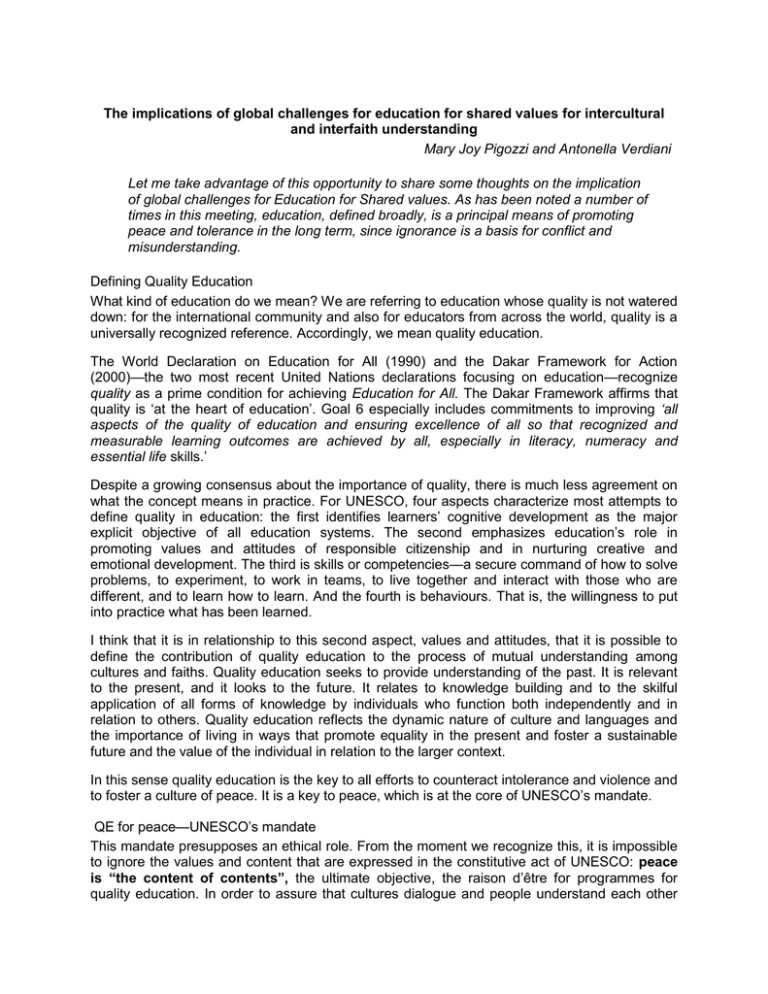
The implications of global challenges for education for shared values for intercultural and interfaith understanding Mary Joy Pigozzi and Antonella Verdiani Let me take advantage of this opportunity to share some thoughts on the implication of global challenges for Education for Shared values. As has been noted a number of times in this meeting, education, defined broadly, is a principal means of promoting peace and tolerance in the long term, since ignorance is a basis for conflict and misunderstanding. Defining Quality Education What kind of education do we mean? We are referring to education whose quality is not watered down: for the international community and also for educators from across the world, quality is a universally recognized reference. Accordingly, we mean quality education. The World Declaration on Education for All (1990) and the Dakar Framework for Action (2000)—the two most recent United Nations declarations focusing on education—recognize quality as a prime condition for achieving Education for All. The Dakar Framework affirms that quality is „at the heart of education‟. Goal 6 especially includes commitments to improving ‘all aspects of the quality of education and ensuring excellence of all so that recognized and measurable learning outcomes are achieved by all, especially in literacy, numeracy and essential life skills.‟ Despite a growing consensus about the importance of quality, there is much less agreement on what the concept means in practice. For UNESCO, four aspects characterize most attempts to define quality in education: the first identifies learners‟ cognitive development as the major explicit objective of all education systems. The second emphasizes education‟s role in promoting values and attitudes of responsible citizenship and in nurturing creative and emotional development. The third is skills or competencies—a secure command of how to solve problems, to experiment, to work in teams, to live together and interact with those who are different, and to learn how to learn. And the fourth is behaviours. That is, the willingness to put into practice what has been learned. I think that it is in relationship to this second aspect, values and attitudes, that it is possible to define the contribution of quality education to the process of mutual understanding among cultures and faiths. Quality education seeks to provide understanding of the past. It is relevant to the present, and it looks to the future. It relates to knowledge building and to the skilful application of all forms of knowledge by individuals who function both independently and in relation to others. Quality education reflects the dynamic nature of culture and languages and the importance of living in ways that promote equality in the present and foster a sustainable future and the value of the individual in relation to the larger context. In this sense quality education is the key to all efforts to counteract intolerance and violence and to foster a culture of peace. It is a key to peace, which is at the core of UNESCO‟s mandate. QE for peace—UNESCO‟s mandate This mandate presupposes an ethical role. From the moment we recognize this, it is impossible to ignore the values and content that are expressed in the constitutive act of UNESCO: peace is “the content of contents”, the ultimate objective, the raison d‟être for programmes for quality education. In order to assure that cultures dialogue and people understand each other and communicate at all levels, from the personal level to that of politics; Education for All must be based on a system of universally recognized values. Definition value, universality The next question is what is meant by values. And what are these values that we call universal? A value is taken to mean an idea or concept that someone thinks is important in life: Like ideas, values do not exist in the world of experience; they exist in people‟s minds. They are standards of conduct, efficiency, or worth, that people endorse and that they try to live up to or maintain. All people have values, although they are not always consciously aware of what these values are. (Fraenkel, 1977) With this in mind, we could say that education for values is an activity in which learners are assisted to make explicit those values underlying their own attitudes and to assess the effectiveness of these values for their long-term well being as well as that of others. When we educate or teach, we communicate values. But which values do we transmit in the act of educating? I think that there are two frames of reference, which are not mutually exclusive but are worthwhile distinguishing here: The first is the frame of humanistic values, which is founded mainly on the Declaration of Human Rights, and has, therefore, universality. These values (respect for others, concern for the knowledge of cultures in all their diversity, the need for international understanding, etc) are those promoted by the system of the United Nations, and especially by UNESCO. According to this vision, humanistic values and human rights provide the basis for the quality of education, including, but not limited to, content. The other, around which it is more difficult to obtain consensus, especially given the present state of the world when, once again, we hear about “wars of religion”, is a vision of values common to all faiths. According to this vision there is a Common Frame of Reference supported not only by those adhering to one of the major religions but those who do not support a particular faith but still appreciate a spiritual component in the human condition. The two approaches do not oppose one another, particularly when we look at those values that are “universally” recognized and shared by both: tolerance, respect, friendship, love, understanding, cooperation, responsibility, etc. It is, therefore, necessary to return to the origins of our different faiths and cultures in order to find the roots that are common to all humanity and that can constitute the foundations for quality education. Values education in practice Regarding this I wish to address a question that is constantly put to us: how do we translate a value, which is essentially a concept, into practice. According to UNESCO, one solution that has given good results is through the learning experience, which can be enhanced through the training of teachers and other educators. A concrete example is a manual for values education prepared by UNESCO and its partners in India: Learning the way of peace, which is based on a model for peace education and nonviolence that is strongly inspired by Oriental philosophies and culture according to which peace is, above all, an inner state. Accordingly the values that must be developed are essentially those of compassion, non-violence, kindness, empathy, cooperation, the truth (according to Gandhian principles). On the basis of this, pedagogical activities and role-playing exercises have been developed for classes or groups of students. This approach is particularly important in work with different ethnic or faith-based groups, because it is possible to lead back to the same values that comprise the ethical basis of all spiritual and faith-based thought. For example, concerning the value of non-violence, which is the foundation for all education for the prevention of conflict, there are references in the Christian New Testament, in the Koran (especially in the Sufi tradition), in Buddhism and in Hinduism. Gandhi contributed greatly to making this value known through his practice of an active militancy that refused conflict, but what was this—other than a message and a discipline of love? Another practical example comes from an area that has seen increased attention recently, sustainable development, a concept that is underpinned by the principles and values that support sustainability in three domains—economic, social, and environmental. For education this means developing learning opportunities that facilitate the development of and respect for these values, starting from the wider definition of development that places Humanity at the centre. It is equally necessary to move the notion of development beyond that of economic growth and of sustainability beyond that of the environment, since no cultural and social development is possible outside of the well being of individuals. The issue of learning the values that enable sustainable human development is a cause for which UNESCO is in the forefront as it is the lead agency for the United Nations Decade of Education for Sustainable Development, beginning in 2005. I believe that to put principles in practice is the challenge with which teachers and, indeed, all educators, are faced in their daily work. Again, to make this practical, I suggest a simple framework that is more generalisable than the first two examples. In the 21st Century we must be working under a new paradigm. We must move from a focus on teaching to a focus on learning. Let‟s put learners at the centre and take an approach that allows us to focus on values as a frequently under-represented part of educational planning. The quality framework Our primary concern is learning, so we must focus on the learner. But, the inputs, processes, environments and outputs that surround and foster, or hamper, learning are key as well. These can be seen as affecting learning at two levels. At the level of the learner in her or his learning environment and at the level of the system that creates and supports the learning experience. Each of these two levels can be divided into five dimensions (see Figure 1). These 10 dimensions of a quality education will be summarised below in light of how values come into play. Both of these levels operate within a specific context, which can vary considerably from location to location. This framework does not emphasise teaching about values. It addresses how values can be put in practice. At the level of the learner Seeking out learners. Values include—non discrimination, equality (especially equal access), inclusivity (including with regard to sex, age, belief system, language and ethnicity). What the learner brings. Values include respect for existing knowledge (indigenous and modern), for family background, for social circumstances, diversity of experiece and skills. Content. Values and descriptors include curriculm that is relevant, truthful, and respectful; curriculum on rights, gender equality, respect for the earth and other life forms, health, nutrition, HIV/AIDS, peace, and respect for and appreciation of diversity, etc. Processes. Values include non-discrimination, dignity, right of expression, equality and respect with regard to culture, language, and gender, for example, and justice. Learning environment. Values include respect for mental and physical health, safety and security, non-violence. The system level Managerial and administrative structure and processes. Values include justice, participation, respect for diversity, respect for learners and other participants in the system, transparency (clear rules and procedures), openness (all, including communities, can bring difficult issues to the fore) Implementation of good policies. Values include commitment to free flow of information, transparency, and coherence among policies. Appropriate legislative framework. Values and descriptors include non-discrimination, equity (possibly affirmative action), fair application of the law, openness, transparency, clear role of the state, consistency with other legally binding instruments, issues relating to corporal punishment. Resources. Values include equity, non-discrimination, and long-term commitments. Measurement of learning outcomes. Honest assessment of the extent to which the intended purposes of education are being met: Knowledge: the essential cognitive achievements that all learners should reach (including literacy, numeracy, core subject knowledge); Values: solidarity, gender equality, tolerance, mutual understanding, respect for human rights, non-violence, respect for human life and dignity; Skills or competencies: to know “how”; and Behaviours: the willingness to put into practice what has been learned. A Global Challenge We are faced with a challenge without precedent: for the first time in the history of humanity we are confronted by phenomena and issues so complex and diverse, from school to society, that it will be increasingly difficult to resolve them with the same elements and the same approaches as those of our parents (in the past, at least in the Western world, this vision was purely Cartesian and materialistic): Albert Einstein said: „The problems that exist in the world today cannot be solved by the level of thinking that created them.‟ Now there is also a need to address the social and other dimensions of learning. Education today is expected to make a contribution to addressing sustainable human development, peace and security, and the quality of life at individual, family, societal, and global levels. From the classrooms to the parliaments, from the interpersonal relations to the media, we have to learn how to communicate, at different levels, with people who have different opinions. It would indeed be dangerous to limit the work of inter-faith and intercultural dialogue only to the convinced and the converted. The need is to reach the hitherto “unreached”. Conclusion In education we have a powerful tool—for good or for evil…for values that are shared or for values that can be imposed. To use this tool for good, for shared values, for learning to live together, for intercultural and interfaith understanding we need to re-orient our education systems so that they reflect a more holistic, and realistic, vision of quality education. We can do it. Let us act! References Fraenkel, J.R. (1977). How to teach about values: an analytical approach Prentice Hall, New Jersey. UNESCO (2000). Dakar Framework for Action http://www.unesco.org/education/efa/ed_for_all/framework.shtml Access date 12 May 2005 UNESCO (1990). The World Declaration on Education for All. http://www.unesco.org/education/efa/ed_for_all/background/jomtien_declaration.shtml. Access date 12 May 12005. Dr Mary Joy Pigozzi Director, Quality Education Division, UNESCO 7 Place de Fontenoy 75007 Paris FRANCE Ph: 33 1 45681099 Fax: 33 1 45685516 Email: mj.pigozzi@unesco.org
